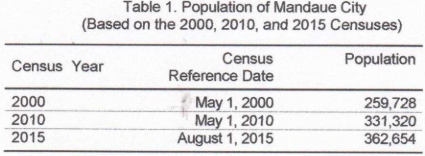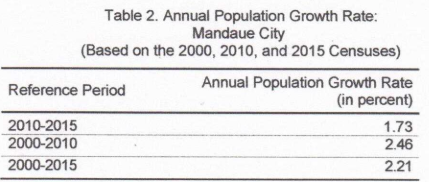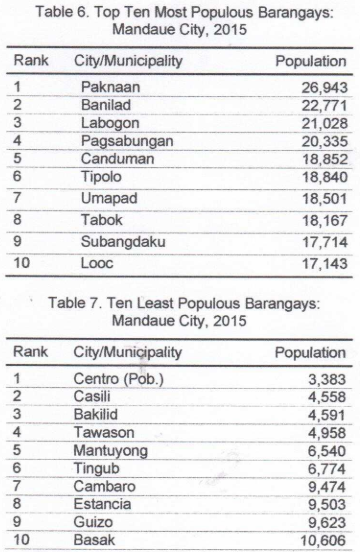The population of Mandaue City as of August 1, 2015 was 362,654 based on the 2015 Census of Population (POPCEN 2015).
The 2015 population of Mandaue City is higher by 31,334 compared with the population of 331,320 in 2010, and by 102,926 compared with the population of 259,728 in 2000. Refer to Table 1.

The population of Mandaue City increased by 1.73 percent annually, on average, during the period 2010 to 2015. By comparison, the rate at which the city’s population grew during the period 2000 to 2010 was higher at 2.46 percent. See Table 2.

Average Household size in 2015 was 4.3 persons
The number of households in 2015 was recorded at 94,547, higher by 16,153 households compared with the 78,394 households posted in 2010. The average household size in 2015 was 3.8 persons, lower than the average household size of 4.2 persons recorded in 2010.

Sex ratio rose to 98 males per 100 females
Of the 362,654 total population in 2015, males accounted for 50.4 percent while females comprised 49.6 percent. These figures resulted in a sex ratio of 101 males for every 100 females, higher than the sex ratio of 98 males per 100 females that was recorded in 2010.

Roman Catholics accounted for 94 percent of the total population
94.5 percent or 362,654 persons of the total population of Mandaue City in 2015 reported Roman Catholic as their religious affiliation. The corresponding figure in 2010 was 95.5 percent (331,320 persons).
The next largest religious affiliation in Mandaue City was Other Religious Affiliations comprising 1.6 percent of the total population. It was followed by those who were affiliated with Other Protestants, with 0.79 percent share.

Among the twenty-seven (27) barangays comprising Mandaue City, Paknaan had the biggest population in 2015 with 26,943, followed by Banilad with 22,771. Centro (Pob.) had the smallest population with 3,383. Refer to Table 4 & 5.
The total population of Barangay Paknaan accounted for about 7.43 percent of the Mandaue City population in 2015.

(SGD) FIRMO C. DIPUTADO
Chief Statistical Specialist
PSA Cebu
TECHNICAL NOTES
Population Growth Rate – the rate at which the population is increasing (or decreasing) in a given period due to natural increase and net migration, expressed as a percentage of the base population.
Total Population – the sum of the household population and institutional population. It also includes Filipinos in Philippine Embassies, consulates and missions abroad.
Household Population – comprises of persons who belong to a household, the basic criterion of which is the usual place of residence or the place where the persons usually resides.
Household – a social unit consisting of a person living alone or a group of persons who sleep in the same housing unit and have a common arrangement in the preparation and consumption of food.
Average household size – the average number of persons who live in the household, computed as the household population in a given area divided by the corresponding total number of households in that area.
Sex ratio – the ratio of males to females in a given population, expressed as the number of males per 100 females.
Religious affiliation – a particular system of beliefs, attitudes, emotions, and behaviors constituting man’s relationship with the powers and principalities of the universe.
The 2015 Census of Population (POPCEN 2015) was undertaken by the Philippine Statistics Authority (PSA) in August 2015 as mandated by Republic Act No. 10625, otherwise known as the Philippine Statistics Act of 2013. It was the 14th census of population that was undertaken since the first census in 1903. POPCEN 2015 was designed to take an inventory of the total population all over the Philippines and collect information about their characteristics. Census day for the POPCEN 2015 was August 1, 2015 (12:01 a.m.). POPCEN 2015 made use of the de jure concept of enumeration wherein households and persons are enumerated in the area where they usually reside as of the census reference date. Enumeration lasted for about 25 days from 10 August to 6 September 2015. Enumeration was extended until 15 September 2016 for large provinces and some highly urbanized cities.

